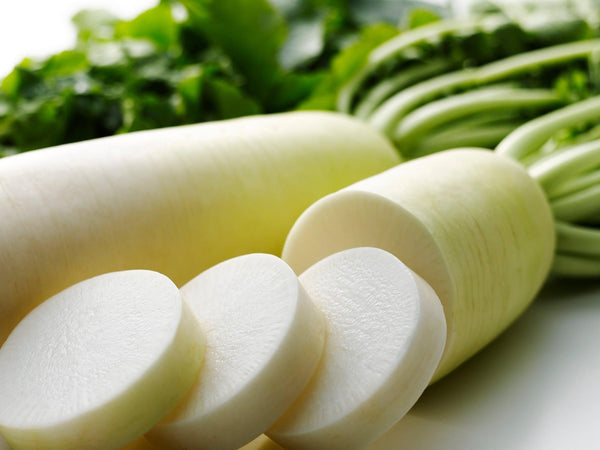
Jump to:
One of the things that will catch your eye on your first trip to a greengrocer or vegetable aisle in a supermarket in Japan is the augmented white root vegetable, known as Daikon. It is distinctive for its long, tubular white root usually up to 50 cm long (although some may reach 2 meters in length), somewhat reminiscent in shape of a super-sized carrot, and its greenish-yellow leaves. Thought by many to be the most beloved of all Japanese vegetables, its presence in various forms strongly pervades all aspects of Japanese cuisine.
In this blog post, we will take a look at a brief history of daikon's consumption around the world and in Japan, its taste profile, how it compares to other types of radishes, and some of the main varieties available.
We shall then examine when the best time to enjoy Daikon is in Japan, how it is prepared in Japanese cooking, and its nutritional and religious significance, and round off by looking at where you can buy Daikon, how to choose the best Daikon, and suggest some tips for storing it.
Daikon Meaning & Origins

Daikon is a perennial plant belonging to the Brassicaceae family (which includes cabbages, cauliflower, broccoli, and kale, as well as radish and turnip). Its name in Japanese comes from the two Kanji characters “大” meaning large, and “根” meaning root, but is commonly referred to as “giant radish” or “winter radish” in English.
Daikon was thought to have been introduced to Japan from southern China in the 8th Century, under the name “O-ne” (based on an alternative reading of the two Kanji characters mentioned above), but did you know that its history in terms of consumption around the world goes way further back than that? Widely thought to be native to the Mediterranean and coastal regions along the Black Sea, records show that it was already cultivated in Ancient Egypt more than 4,000 years ago, and very likely formed part of the diet of the workers who built the pyramids.
Now, Daikon is grown in many regions of Japan and its resilience against cold temperatures (it is said to be able to withstand temperatures as low as -3℃) is one reason why Hokkaido ranks as the largest producer of Daikon by prefecture.
What Does Daikon Taste Like?

Daikon has a mild flavor with a distinctive peppery bite, as well as a crunchy texture. When boiled in a broth, it easily absorbs the flavors of the food it is cooked with. In fact, there is a difference in the sweetness and pungency of Daikon between its upper and lower parts. The upper part of the daikon (leaf tip end) is sweeter, whereas its pungency increases as you move to the lower part of the Daikon (root end)
As we shall discuss later in the section on nutrition, one of the key benefits of eating daikon is the way that it aids the digestion of many other food types, but its unique taste has meant that even in cases where it was introduced primarily for that purpose, it has become an indispensable part of our association with the dish in question. Try, for example, thinking of the experience of eating tempura, without the refreshing spiciness and mild sweetness of grated Daikon and soy sauce.
Daikon Vs Other Kinds Of Radishes?

Many people from Western countries are surprised, on first coming to Japan, to hear Daikon spoken about as a radish. This is because it bears scarcely any resemblance to the small, red bulb-shaped vegetables referred to as radishes in their own countries. Among other differences, Daikon is sweeter, juicier, and less spicy and peppery than red radishes.
Another type of radish is the Korean radish or Mu. This is perhaps closer to the long, white Daikon, but its shape is closer to that of a potato. There is also the watermelon radish, which is a variety of Chinese radish. This has the same texture and crunch as Japanese and red radishes but has a mellower flavor. It is green on the outside and pink on the inside, hence its name.
Types Of Daikon
Daikon may all look the same to the untrained eye, but it is said that there were once more than 100 varieties of Daikon eaten in mainland Japan. Its cultivation is far more focused these days, and we have introduced several types commonly found in Japan below.
Aokubi Daikon (literally “green-necked Daikon)

This is your garden variety, bog standard type of Daikon that accounts for 95% of production and consumption in Japan. So named because its head, visible at the base of the leaves, takes on a light green color in sunlight, it is characterized by its resilient skin and sweet taste. Not fuzzy about soil or temperature, it can be grown in all regions of Japan, all year around, hence its unmatched prevalence in the Daikon market.
Moriguchi Daikon

Hailing originally from the Moriguchi district of Osaka in ancient times, the main thrust of its production is in the prefecture of Osaka, where it is grown along the Kiso river basin and Aichi Prefecture. This is the largest type of Daikon, often exceeding one meter, and it boasts a spicy taste and firm texture. Moriguchi-zuke is a type of pickled Daikon produced through three years of repeated pickling in sake and sake lees.
There are other varieties named after their region of production including Nerima Daikon, produced mainly in the northeastern Tokyo ward of the same name, and Miura Daikon from the Miura peninsula, also in the Kanto area.
When Is Daikon In Season?
As Daikon can withstand cold temperatures and is produced in a large number of regions throughout Japan, it can be enjoyed in Japanese supermarkets the whole year round. The main season for Daikon, however, is considered fall to winter, and in particular, the months from September to December when Daikon consumption is at its peak. The root tends to be juicier and sweeter during this period and thus is a particularly recommended time to enjoy it raw in salads and as pickles.
Different Ways Of Enjoying Daikon

Daikon is consumed in a virtually infinite number of ways. It can be eaten with and without the skin, and when raw, the flesh can be thinly sliced, chopped, or cubed as a crisp side dish or part of a salad. In Japan, Daikon is often served in the form of a refreshing accompaniment to tempura and other deep-fried dishes, as a reprieve from the heavier flavors and textures.
Daikon can be cut into a long and stringy form as a noodle substitute (particularly popular with those on keto or other low-carb diets), thinly sliced for sandwiches, layered into spring rolls, or julienned and pickled with other vegetables. It is a popular ingredient when pickled and fermented into kimchi in Korea, which is a staple dish utilized as a condiment, side dish, or dip.
Daikon can also be cooked to develop a starchy texture similar to a potato, and this form accounts for some of its most popular dishes, where the Daikon absorbs the flavor of the broth or juice that it is cooked in, such as O-den, nabe, and Buri-daikon.
Looking beyond the roots, Daikon leaves are edible and highly nutritious. They can be tossed into salads, sauteed as a side dish, or added to miso soup. They also form a common ingredient in furikake, the dry Japanese condiment sprinkled on top of cooked rice.
Is Daikon Good For You Both Physically and Spiritually?
In addition to high levels of Vitamin C, which is important for boosting the immune system and general promotion of well-being, it is high in dietary fiber, including diastase, a starch-digesting enzyme, as well as allyls that promote the secretion of gastric juices. Daikon has elements that aid the digestion of starch, protein, and fat.
Its overall digestive qualities are said to be behind the labeling of less competent thespians as Daikon Yakusha (literally, “daikon actors”). It comes from a play on the Japanese word “ataranai”. In the culinary world, this means that it won’t upset your stomach, but it also is used to refer to an actor who stinks the gaff out.
The leaves of the Daikon are also extremely nutritious and have even higher levels of Vitamin C, as well as beta-carotene not found in the root.
The previously mentioned diastase enzyme also has a powerful detoxifying effect and its ability to nullify the carcinogens in the charred parts of grilled fish is another reason grated Daikon is so often matched with fish.
This purification theme is also a component of religious sentiment around Daikon. The Matsuchiyama Shoden Temple is a sub-temple of Sensoji Temple, Tokyo’s oldest temple. It is one of the few Buddhist sites that accept Daikon as offerings. In the main temple building, Daikon radishes are incorporated into the intricate designs seen on the walls, and there is frequently a large pile of Daikon placed in front of the altar as offerings from visitors. In January, the temple holds the Daikon Matsuri, an annual event where Daikon radishes are cooked and served to visitors as a cleansing ritual.
What Daikon To Buy & Where?

Daikon can be found in all greengrocers and supermarkets in Japan. These days, Daikon has become a popular vegetable eaten outside of Japan, meaning that it can commonly be found in Japanese or Asian supermarkets, and even in local supermarkets.
When choosing Daikon, select a plant that is thick, straight, taut, and shiny throughout. If the Daikon is cut, check for a fine-textured cross-section and the absence of cracks. The leaves can be eaten right down to the root, so select plants with dark green leaves.
Whole or cut Daikon can be stored in the fridge for approximately one week, but if you struggle to consume that much Daikon within such a short time, the Daikon can be cut into sections, wrapped in kitchen paper, and placed in a plastic bag, after which it can be safely refrigerated for up to one month.
Daikon – Much Loved For A Reason
As discussed, Daikon is a highly versatile vegetable, which can be enjoyed in a myriad of different ways the whole year round, and it holds a special place in the hearts of Japanese people. It is relatively inexpensive, and both the root and the leaves are highly nutritious, thus ticking all the boxes for a must-have addition to your culinary repertoire.
What is your favorite way of eating Daikon? Are you a fan of Daikon in O-den with a touch of mustard, or is grated Daikon with soy sauce and tempura or soba noodles more your thing? Please let us know in the comments.


0 comments